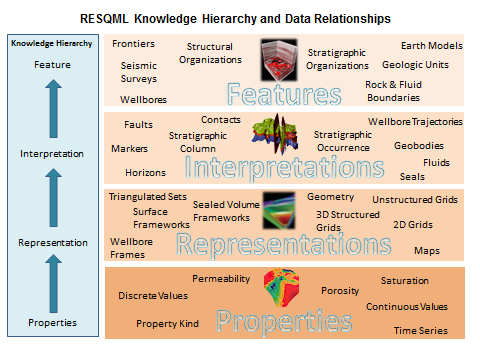5 Knowledge Hierarchy : Features, Interpretations, Representations , and Properties
| Topic Version | 1 | Published | 09/11/2015 | |
| For Standard | RESQML v2.0.1 | |||
As introduced earlier in Chapter 3 Organization and Key Concepts: Overview , RESQML v1.1 had the concept of data "versions." RESQML has now expanded the concept of "data" to include the relationships between data objects, which allows a more precise classification.
The current design now supports the transfer of abstract subsurface features, human interpretations of those features, the data representations of those interpretations, and the properties indexed onto those representations, which results in a well-defined knowledge hierarchy of feature/interpretation/representation/properties (informally referred to as "FIRP")—a key organizing concept in RESQML (Figure 5-1). Additionally geometry is integral to RESQML organization.
The knowledge hierarchy is set up to associate and retrieve the different levels of information on data objects exchanged between software applications, in context, which essentially allows users to monitor the progress of the related business processes.
This chapter:
- Provides definitions for features, interpretations, representations and properties concepts, and introduces topology and geometry.
- Explains how these different levels of data objects fit together into a knowledge hierarchy—a crucial new RESQML concept for more precise data organization and more efficient data exchange—and refers to specific detailed chapters, as necessary.
- Explains how to specify relationships between data objects in RESQML.
